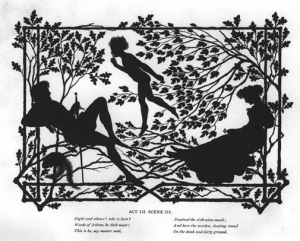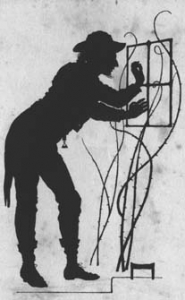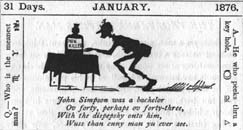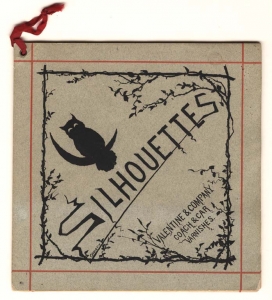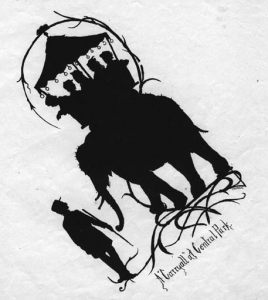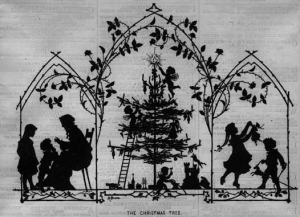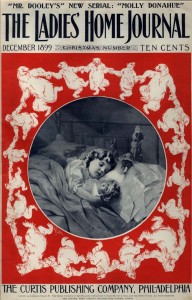During the 18th and well into the 19th century silhouette portraiture was a popular means for Americans to preserve likenesses of themselves. Often created by itinerate artists and with the aid of various devices, silhouettes were produced as unique works or at most in limited numbers of copies.* By mid-19th century photographic techniques rapidly displaced silhouette portraits and the art forum disappeared. In 1850, Nathaniel Hawthorne placed a daguerreotypist in a far wing of his seven gabled house, a sure sign of the times.
Paul Konewka (1841-1871)
Midsummer Night’s Dream, Act III, Scene III, 1870
Illustration for Shakespeare’s A Midsummer Night’s Dream (Boston: Roberts Brothers, 1870): frontispiece
wood engraving by William H. Morse of a cut silhouette
From the authors’ archives
Paul Konewka (1841-1871), a Polish/German artist is credited with reviving the silhouette, but as illustration rather than portraiture. Working in Berlin during the 1860’s, Konewka created illustrations for several books including Shakespeare’s Midsummer Night’s Dream and Goethe’s Faust.** True to tradition, Konewka created his silhouettes, at least in part, with scissors and black paper. By 1870 his works were published in Boston by Roberts Brothers (see above) who, through the use of wood engravings, continued publishing Konewka illustrated volumes through 1874. The books received favorable, if not enthusiastic, comments from Harper’s Monthly.***
Winslow Homer (1836-1910)
Zekle crep’ up quite unbeknown an’ peeked in thru’ the winder, 1874
Illustration for James Russell Lowell poem The Courtin’ (Boston: James R. Osgood and Company, 1874): frontispiece
Heliograph from drawing by the artist
From the authors’ archives
Konewka’s silhouette illustrations did not go unnoticed by American illustrators and publishers, but unlike Konewka, most American silhouettists created their works with brush and pen. In 1874, James R. Osgood and Company of Boston published James Russell Lowell’s poem, The Courtin’ illustrated with seven silhouettes created by Winslow Homer (see one above). The illustrations are described on the title page as: “Reproduced in heliotype from drawings by Winslow Homer.” The heliograph, patented in 1870 was a photographic process suited to producing the sharp edges and high contrast required in printing silhouettes.
Livingston Hopkins (1846-1927)
January, 1876
Illustration for in Josh Billings’ Farmer’s Alminax (New York: G. W. Carlton & Co., 1876)
Wood engraving
From the authors’ archives
During the 1870s, Josh Billings (Henry Wheeler Shaw, 1818-1885) wrote Josh Billings’ Farmer’s Alminax, published by G.W. Carleton of New York. The page for each month consisted of a humorous cartoon at the top with four lines of verse; the calendar below included more humorous comments. The cartoons for 1874 were silhouettes, unsigned. Silhouettes reappeared in 1876, with the January, April, May, and December cartoons signed “Hopkins” (see above). Being similar in artistic style, the cartoons for both years are undoubtedly the work of Livingston Hopkins.
F. S. Church (1842-1924) F. S. Church (1842-1924)
Silhouettes, 1876 A Carryall at Central Park, in Silhouettes, 1876
Valentine Varnish Company, front cover Valentine Varnish Company
Wood engraving Wood engraving
Fom the authors’ archives From the authors’ archives
Frederick Stuart Church joined the ranks of American silhouettists when he created Morning, Noon, and Night published in Harper’s Bazar, December 18, 1875. Three panels depict a day in the life of a New York harbor long shore man. Soon after, Church’s friend and patron, Lawson Valentine, commissioned him to create a series of silhouettes to be included in a promotional booklet for the Valentine Varnish Company (see above). The booklet was printed by Estes and Lauriat of Boston in 1876 and included 16 silhouettes all based on a theme of coaches and wagons (see above). The Valentine Varnish Company booklet must have appealed to Estes and Lauriat for they reissued a similar volume under their name with “1st Series” in the title, it included ads for their publications inside the front cover and outside the back cover with 12 images from the Valentine edition. Also in 1878 they published a second booklet of silhouettes by F. S. Church, it was titled “2nd Series”. This booklet included 15 additional new silhouettes with a railroad theme; the ads were identical to those of the 1st series but the covers were printed with red ink. None of the three silhouette booklets included text. Not inclined to allow a resource to lie idle, in 1878 Estes and Lauriat published Babyhood: Rhymes and Stories, Pictures and Silhouettes, for Our Little Ones by Laura E. Richards (1850-1943). Babyhood included seventeen silhouettes by Church as illustrations. In Babyhood appropriate text accompanies the silhouettes, however this appears to be an example of text written to fit the illustrations.
Heinrich Braun (n.d.)
The Christmas Tree, 1876
Story illustration for The Daily Graphic (December 23, 1876)
Heliograph/lithograph
From the authors’ archives
The silhouette revival also included periodicals. For example the Daily Graphic out of New York, employed a combination of photography and lithography to print illustrations, a technique capable of producing bold lines suitable for printing silhouettes. Silhouettes appeared frequently in the Daily Graphic from 1874 to 76, often in the large front-page illustration as well as smaller illustrations inside the paper (see above). Silhouettes appeared in St. Nicholas, a popular magazine for children. Howard Pyle (1853-1911) used silhouettes to illustrate a story in a September 1877 issue**** and Livingston Hopkins created silhouette illustrations for St. Nicholas in December 1879. Wood engravings were the preferred method for printing illustrations in St. Nicholas; it is likely that this technique was used to print the silhouette images as well. In fact silhouette figures sometimes appeared in an illustration surrounded by traditional wood engraved scenery.
F. S. Church (1842-1924)
Cover illustration for The Ladies’ Home Journal (December 1899)
From the authors’ archives
By the close of the 1870’s the use of silhouette illustrations began to diminish but did not disappear, it remained an important technique for the illustrator’s artistic expression. F. S. Church’s wreath of white on red silhouette bears provided just the right dream-like ambience for the sleeping child at the center of the Ladies’ Home Journal cover for December 1899 (see above).
* www.peggymcclard.com/aaa%20History%20of%20Silhouettes.htm
** https://de.wikipedia.org/wiki/Paul_Konewka
*** https://memory.loc.gov/ammem/ndlpcoop/moahtml/title/harp -vols.html ; select January 1871, p. 303; February 1871, p. 460, and January 1872, 298- 9.
**** www.rockwell-center.org/exploring-illustratio/silhouettes-on-a-shade/
For more on F. S. Church see, Frederick Stuart Church: A Brush with Imagination by W. Dale Horst and Rose Marie Horst (Goose Pond Press, 2010)
March 20, 2014
By W. Dale Horst and Rose Marie Hors


